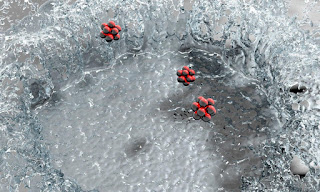The small liquid robots can run as long they have "food".
Image 1:
The liquid nanomachines that can operate without electricity might be connected with microchips. Those microchips can equip with a small mustache. That it can use to control the direction where that small nanomachine should go. The microchip can get electricity from outcoming radiowaves. Or they can get energy from the rolling nanomachine itself. Which turned into a nano-generator.
The new liquid nano-size robots can be fascinating tools. The first aqueous robots that can move in liquid are under research. The tiny robots can walk on the surface of the water. Or which can visit below the surface and then return are tools that are giving a great improvement in nanotechnology.
But if researchers are creating the nano rolls. That rolls on the surface of the water that tool will have possibilities that have never been before. Those nano-rolls could use as nano-size generators for nanotechnical microchips. The ability to connect the robots. That can move without electricity to the electric production. That kind of thing has a great future in the world of nanotechnology.
Image: 2
The superconducting layer makes it possible to create helium-based nanomachines that are hovering above the superconducting layer.
The nano-rolls or nanomachines can hover above the layer by benefiting the electron pillar. When a nano-size machine is put near the superconducting layer. The electrons would start to travel between that object and the layer. If the electrons of the layer and the nano-object are towards each other. T hat effect makes the nano-structure hover above the layer.
The helium nano-crystals or nano-droplets can use as nanomachines. Those atom-sized machines can move objects above the superconducting layers.
The system can use the same tunneling effect. That a scanning tunneling microscope uses. That nano-crystal can hang in a physical stylus or an electromagnetic field.
Those helium or some other atom-based nanomachines are like small UFOs. The helium is suitable for that work because the atom has a corner that can position the layer. The molecule or atom should be like a small pyramid that is upside down.
Then the nanomachines would rise to hover above the extremely cold superconducting layer by using quantum tunneling. A machine that size is about one or two atoms. Would hover on the top of the quantum pilar. That is formed by the same effect that is used in a scanning tunneling microscope. The atom can hang in a stylus or electromagnetic field.
Then the operator can move those nanomachines by shooting them with a laser. Or that person can control the location of the nanomachine by using a maser or coherent radio or microwaves. Those hovering nanomachines can move other atoms over the layer.
https://scitechdaily.com/helium-bath-splash-physicists-discover-surprising-phenomenon/
https://scitechdaily.com/these-tiny-liquid-robots-never-run-out-of-energy-as-long-as-they-have-food/
Image1) https://scitechdaily.com/these-tiny-liquid-robots-never-run-out-of-energy-as-long-as-they-have-food/
Image 2) https://scitechdaily.com/helium-bath-splash-physicists-discover-surprising-phenomenon/
https://thoughtsaboutsuperpositions.blogspot.com/






No comments:
Post a Comment
Note: Only a member of this blog may post a comment.